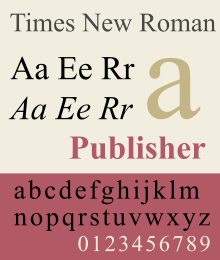Times New Roman
Times New Roman is a serif typeface. It was made for legibility (easy reading) in body text. It was created by the British newspaper The Times in 1931. It was made by Stanley Morison, the artistic advisor to the British part of the newspaper. Victor Lardent, a lettering artist at Times advertising department, helped him make it.
 | |
| Category | Serif |
|---|---|
| Classification | Transitional Old-style |
| Designer(s) | Stanley Morison Victor Lardent |
| Commissioned by | The Times |
| Foundry | Monotype |
| Date made available | 1932[1] |
| License | Proprietary |
| Design based on | Plantin |
| Metrically compatible with | Tinos |
The font is no longer used by the Times newspaper. It is used mostly in books and general printing. It has become a regular typeface used on most computers.
As a typeface used for newspapers, Times New Roman allows tight line-spacing and a smaller appearance. It was first seen in the Times on 3 October 1932.[2][3]
Design
changeTimes New Roman pronunciation (help·info) is packed together, with tall lowercase letters. These things make it easier to read.
References
change- ↑ Clarke, C.F.O. (1946). "The Times: A Revolution in Newspaper Printing". Graphis. pp. 362–375. Archived from the original on 27 February 2021. Retrieved 15 December 2016.
- ↑ "Times New Roman". Typolis.de. Retrieved February 22, 2019.
- ↑ "Times New Roman". Graphis. Archived from the original on 2019-01-27. Retrieved February 22, 2019.